light TOYOTA HIGHLANDER 2017 XU50 / 3.G Quick Reference Guide
[x] Cancel search | Manufacturer: TOYOTA, Model Year: 2017, Model line: HIGHLANDER, Model: TOYOTA HIGHLANDER 2017 XU50 / 3.GPages: 56, PDF Size: 3.78 MB
Page 15 of 56
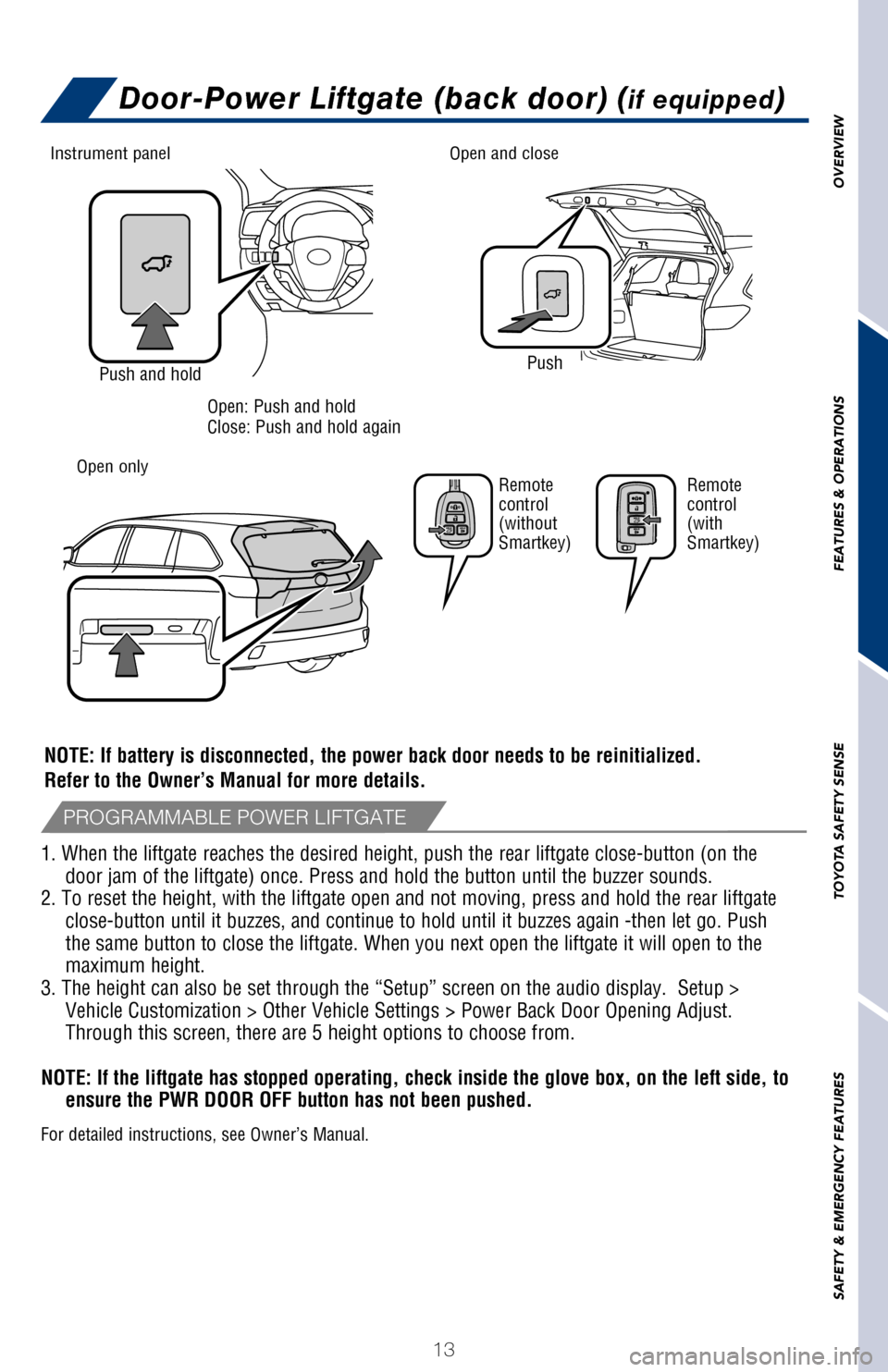
OVERVIEW
FEATURES & OPERATIONS
TOYOTA SAFETY SENSE
SAFETY & EMERGENCY FEATURES
13
Door-Power Liftgate (back door) (if equipped)
If the moon roof is open, pressing the switch
closes it up to the tilt-up position.
If the shade is closed past the half-open position
when the switch is pressed, it will open up to the
half-open position.
The moon roof stops slightly before the fully open position to reduce wi\
nd noise and the
shade opens fully. Slide the switch again to fully open or close the moo\
n roof.
PushPush and hold
Instrument panel Open and close
Open: Push and hold
Close: Push and hold again
NOTE: If battery is disconnected, the power back door needs to be reinitialize\
d.
Refer to the Owner’s Manual for more details.
Open onlyRemote
control
(without
Smartkey)Remote
control
(with
Smartkey)
1. When the liftgate reaches the desired height, push the rear liftgate \
close-button (on the
door jam of the liftgate) once. Press and hold the button until the buz\
zer sounds.
2. To reset the height, with the liftgate open and not moving, press and\
hold the rear liftgate close-button until it buzzes, and continue to hold until it buzzes again\
-then let go. Push
the same button to close the liftgate. When you next open the liftgate i\
t will open to the
maximum height.
3. The height can also be set through the “Setup” screen on the au\
dio display. Setup > Vehicle Customization > Other Vehicle Settings > Power Back Door Opening\
Adjust.
Through this screen, there are 5 height options to choose from.
NOTE: If the liftgate has stopped operating, check inside the glove box,\
on the left side, to ensure the PWR DOOR OFF button has not been pushed.
For detailed instructions, see Owner’s Manual.
PROGRAMMABLE POWER LIFTGATE
TILTING OPERATION
TILTING OPERATION
2017_Highlander_QRG_V1_1.indd 1311/22/16 11:28 PM
Page 18 of 56
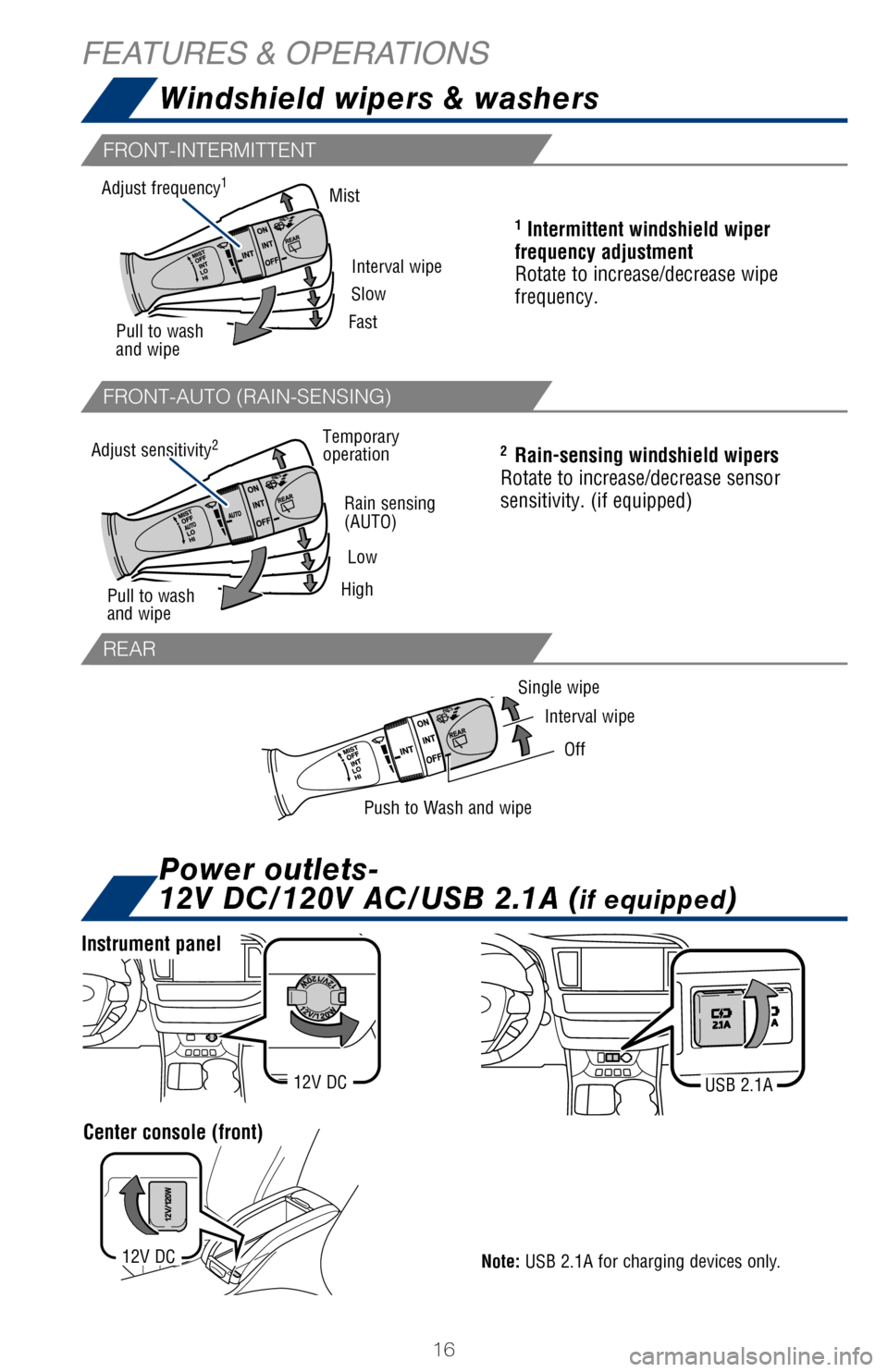
16
Instrument panel
USB 2.1A12V DC
The “ENGINE START STOP”/ignition switch must be in the “ACC”\
or “ON” position to be used.
Center console (front)
Single wipeInterval wipe
Off
Push to Wash and wipe
1 Intermittent windshield wiper
frequency adjustment
Rotate to increase/decrease wipe
frequency.
2 Rain-sensing windshield wipers
Rotate to increase/decrease sensor
sensitivity. (if equipped)Temporary
operation
Rain sensing
(AUTO)Low
HighAdjust sensitivity2
Pull to wash
and wipe
Interval wipe
Mist
Slow
Fast
Adjust frequency
1
Pull to wash
and wipe
Center console (rear)
Front fog lights come on only when the headlights are on low beam.
Daytime Running Light system (DRL) (if equipped)
Automatically turns on the headlights at
a reduced intensity. Automatic light cut off system Lights automatically turn off after a delay of 30 seconds, or
when lock switch on remote is pushed after all doors are locked.
Parking lights
DRL OFF
With DRL OFF switch
12V DC
12V DC
Note: USB 2.1A for charging devices only.
HEADLIGHTS
FRONT FOG LIGHTS
TURN SIGNALS
FEATURES & OPERATIONS Windshield wipers & washers
Power outlets-
12V DC/120V AC/USB 2.1A (
if equipped)
FRONT-INTERMITTENT
FRONT-AUTO (RAIN-SENSING)
REAR
2017_Highlander_QRG_V1_1.indd 1611/22/16 11:29 PM
Page 19 of 56
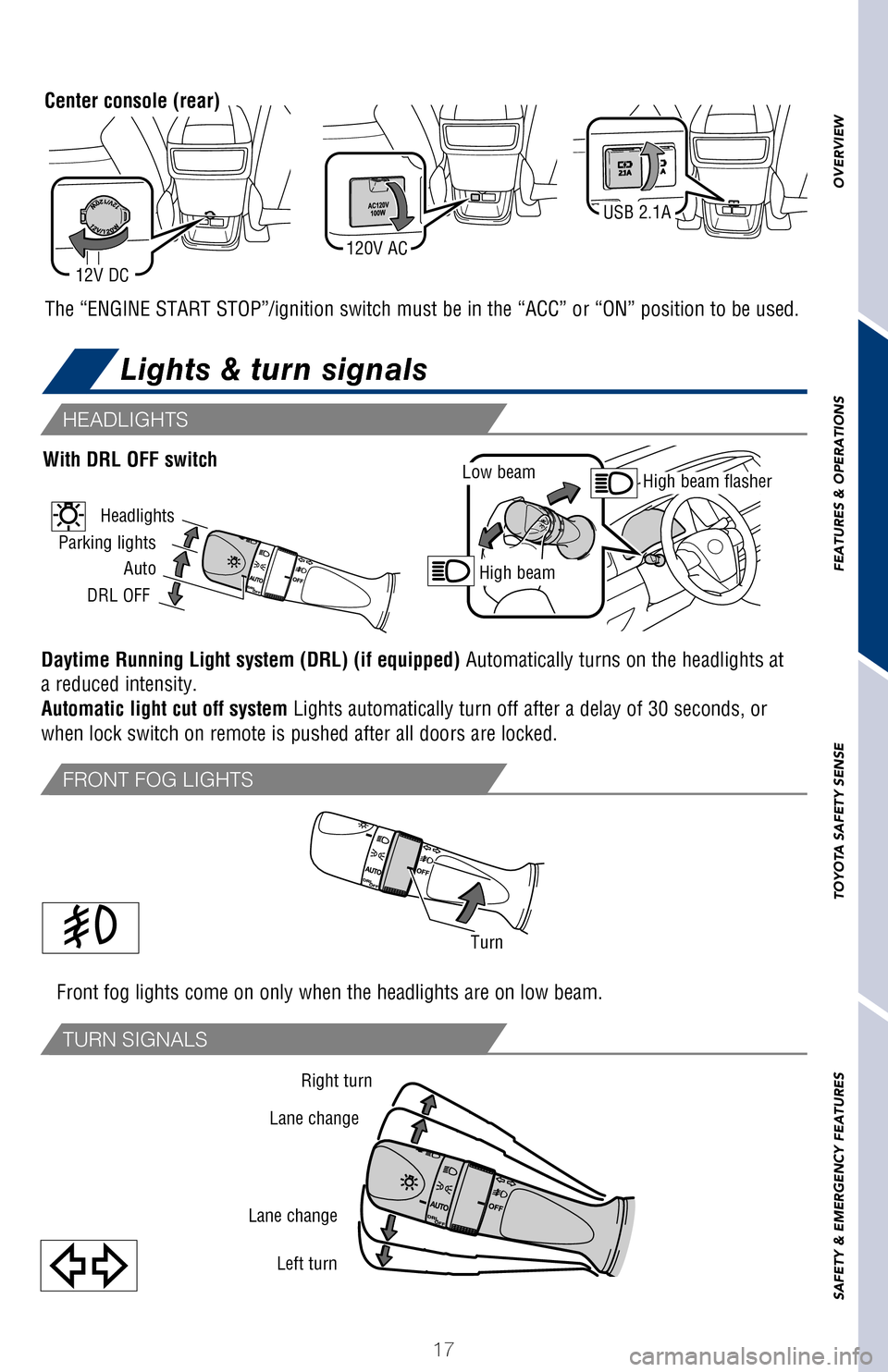
OVERVIEW
FEATURES & OPERATIONS
TOYOTA SAFETY SENSE
SAFETY & EMERGENCY FEATURES
17
The “ENGINE START STOP”/ignition switch must be in the “ACC”\
or “ON” position to be used.
2 Rain-sensing windshield wipers
Rotate to increase/decrease sensor
sensitivity. (if equipped)
Center console (rear)
Front fog lights come on only when the headlights are on low beam.
Daytime Running Light system (DRL) (if equipped) Automatically turns on the headlights at
a reduced intensity. Automatic light cut off system Lights automatically turn off after a delay of 30 seconds, or
when lock switch on remote is pushed after all doors are locked.
Low beam
High beam
High beam flasher
Parking lights
Auto
DRL OFF
With DRL OFF switch
Headlights
Turn
Right turn
Lane change
Lane change Left turn
120V AC
12V DC
USB 2.1A
Note: USB 2.1A for charging devices only.
Lights & turn signals
HEADLIGHTS
FRONT FOG LIGHTS
TURN SIGNALS
Windshield wipers & washers
Power outlets-
12V DC/120V AC/USB 2.1A (
if equipped)
2017_Highlander_QRG_V1_1.indd 1711/22/16 11:29 PM
Page 28 of 56
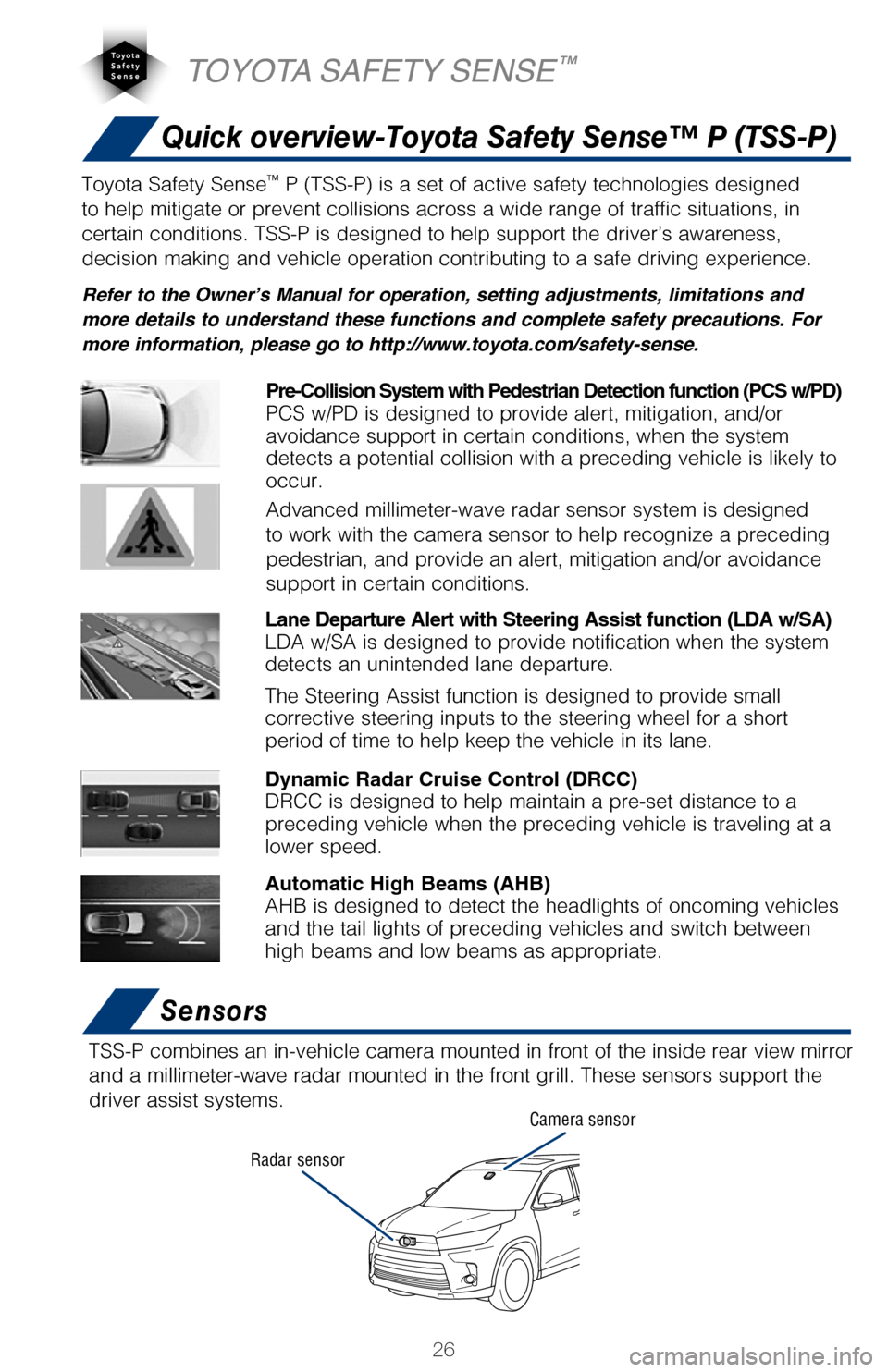
26
Quick overview-Toyota Safety Sense™ P (TSS-P)
Sensors
TSS-P combines an in-vehicle camera mounted in front of the inside rear \
view mirror
and a millimeter-wave radar mounted in the front grill. These sensors su\
pport the
driver assist systems.
Camera sensor
Radar sensor
TOYOTA SAFETY SENSE™
The Pre-Collision System uses a radar sensor and camera sensor to help d\
etect
vehicles and pedestrians in front of your vehicle.
As there is a limit to the degree of recognition accuracy and control pe\
rformance
that this system can provide, do not overly rely on this system. This sy\
stem will not
prevent collisions or lessen collision damage or injury in every situati\
on. Do not use
PCS instead of normal braking operations under any circumstances. Do not\
attempt
to test the operation of the pre-collision system yourself, as the syste\
m may not
operate or engage, possibly leading to an accident. In some situations, \
such as
when driving in inclement weather such as heavy rain, fog, snow or a san\
dstorm or
while driving on a curve and for a few seconds after driving on a curve,\
a vehicle
may not be detected by the radar and camera sensors, preventing the syst\
em from
operating or engaging properly.
Refer to a Toyota Owner’s Manual for a list of additional situations \
in which the
system may not operate properly.
Refer to a Toyota Owner’s Manual for additional information on PCS w/\
PD operation,
settings adjustments, limitations, and precautions before attempting to \
use it. Pre-Collision Warning
When the system determines that the possibility of a frontal collision i\
s high, a
buzzer will sound and a warning message will be displayed on the Multi-I\
nformation
Display (MID) to urge the driver to take evasive action.
Pre-Collision Brake Assist
If the driver notices the hazard and brakes, the system may provide addi\
tional
braking force using Brake Assist. This system may prime the brakes and m\
ay apply
greater braking force in relation to how strongly the brake pedal is dep\
ressed.
Pre-Collision Braking
If the driver does not brake in a set time and the system determines tha\
t the
possibility of a frontal collision with a preceding vehicle is extremely\
high, the
system may automatically apply the brakes, reducing speed in order to he\
lp the
driver reduce the impact and in certain cases avoid the collision.
Toyota Safety Sense™ P (TSS-P) is a set of active safety technologies designed
to help mitigate or prevent collisions across a wide range of traffic si\
tuations, in
certain conditions. TSS-P is designed to help support the driver’s aw\
areness,
decision making and vehicle operation contributing to a safe driving exp\
erience.
Refer to the Owner’s Manual for operation, setting adjustments, limitations and
more details to understand these functions and complete safety precautions. For
more information, please go to http://www.toyota.com/safety-sense.
Lane Departure Alert with Steering Assist function (LDA w/SA)
LDA w/SA is designed to provide notification when the system
detects an unintended lane departure.
The Steering Assist function is designed to provide small
corrective steering inputs to the steering wheel for a short
period of time to help keep the vehicle in its lane.
Automatic High Beams (AHB)
AHB is designed to detect the headlights of oncoming vehicles
and the tail lights of preceding vehicles and switch between
high beams and low beams as appropriate.
Pre-Collision System with Pedestrian Detection function (PCS w/PD)
PCS w/PD is designed to provide alert, mitigation, and/or
avoidance support in certain conditions, when the system
detects a potential collision with a preceding vehicle is likely to
occur.
Advanced millimeter-wave radar sensor system is designed
to work with the camera sensor to help recognize a preceding
pedestrian, and provide an alert, mitigation and/or avoidance
support in certain conditions.
Dynamic Radar Cruise Control (DRCC)
DRCC is designed to help maintain a pre-set distance to a
preceding vehicle when the preceding vehicle is traveling at a
lower speed.
2017_Highlander_QRG_V1_1.indd 2611/22/16 11:29 PM
Page 29 of 56
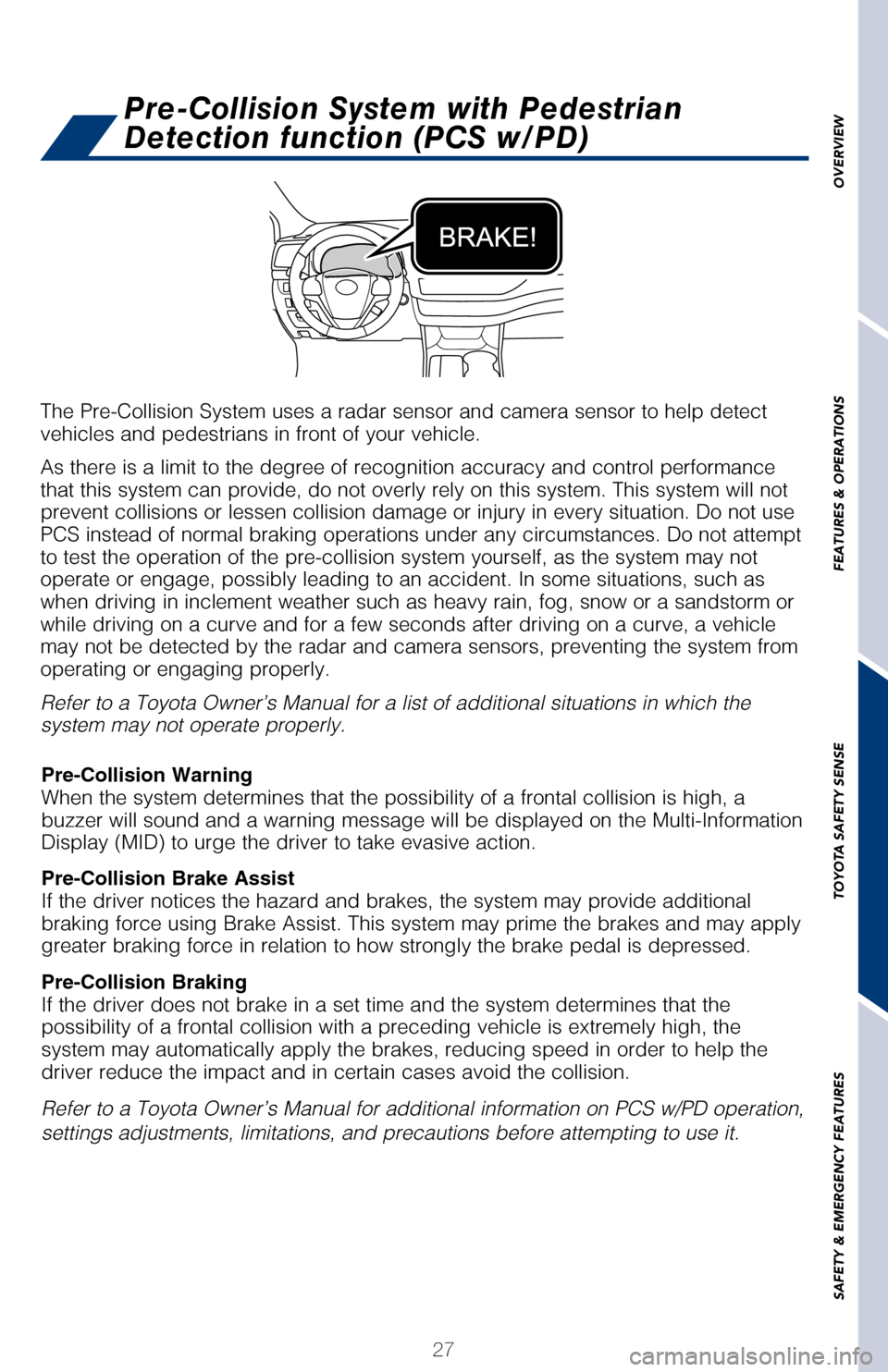
27
OVERVIEW
FEATURES & OPERATIONS
TOYOTA SAFETY SENSE
SAFETY & EMERGENCY FEATURES
Quick overview-Toyota Safety Sense™ P (TSS-P)
Sensors
TSS-P combines an in-vehicle camera mounted in front of the inside rear \
view mirror
and a millimeter-wave radar mounted in the front grill. These sensors su\
pport the
driver assist systems.
The Pre-Collision System uses a radar sensor and camera sensor to help d\
etect
vehicles and pedestrians in front of your vehicle.
As there is a limit to the degree of recognition accuracy and control pe\
rformance
that this system can provide, do not overly rely on this system. This sy\
stem will not
prevent collisions or lessen collision damage or injury in every situati\
on. Do not use
PCS instead of normal braking operations under any circumstances. Do not\
attempt
to test the operation of the pre-collision system yourself, as the syste\
m may not
operate or engage, possibly leading to an accident. In some situations, \
such as
when driving in inclement weather such as heavy rain, fog, snow or a san\
dstorm or
while driving on a curve and for a few seconds after driving on a curve,\
a vehicle
may not be detected by the radar and camera sensors, preventing the syst\
em from
operating or engaging properly.
Refer to a Toyota Owner’s Manual for a list of additional situations \
in which the
system may not operate properly.
Refer to a Toyota Owner’s Manual for additional information on PCS w/\
PD operation,
settings adjustments, limitations, and precautions before attempting to \
use it. Pre-Collision Warning
When the system determines that the possibility of a frontal collision i\
s high, a
buzzer will sound and a warning message will be displayed on the Multi-I\
nformation
Display (MID) to urge the driver to take evasive action.
Pre-Collision Brake Assist
If the driver notices the hazard and brakes, the system may provide addi\
tional
braking force using Brake Assist. This system may prime the brakes and m\
ay apply
greater braking force in relation to how strongly the brake pedal is dep\
ressed.
Pre-Collision Braking
If the driver does not brake in a set time and the system determines tha\
t the
possibility of a frontal collision with a preceding vehicle is extremely\
high, the
system may automatically apply the brakes, reducing speed in order to he\
lp the
driver reduce the impact and in certain cases avoid the collision.
Pre-Collision System with Pedestrian
Detection function (PCS w/PD)
Toyota Safety Sense™ P (TSS-P) is a set of active safety technologies designed
to help mitigate or prevent collisions across a wide range of traffic si\
tuations, in
certain conditions. TSS-P is designed to help support the driver’s aw\
areness,
decision making and vehicle operation contributing to a safe driving exp\
erience.
Refer to the Owner’s Manual for operation, setting adjustments, limitations and
more details to understand these functions and complete safety precautions. For
more information, please go to http://www.toyota.com/safety-sense.
Lane Departure Alert with Steering Assist function (LDA w/SA)
LDA w/SA is designed to provide notification when the system
detects an unintended lane departure.
The Steering Assist function is designed to provide small
corrective steering inputs to the steering wheel for a short
period of time to help keep the vehicle in its lane.
Automatic High Beams (AHB)
AHB is designed to detect the headlights of oncoming vehicles
and the tail lights of preceding vehicles and switch between
high beams and low beams as appropriate. Pre-Collision System with Pedestrian Detection function (PCS w/PD)
PCS w/PD is designed to provide alert, mitigation, and/or
avoidance support in certain conditions, when the system
detects a potential collision with a preceding vehicle is likely to
occur.
Advanced millimeter-wave radar sensor system is designed
to work with the camera sensor to help recognize a preceding
pedestrian, and provide an alert, mitigation and/or avoidance
support in certain conditions.
Dynamic Radar Cruise Control (DRCC)
DRCC is designed to help maintain a pre-set distance to a
preceding vehicle when the preceding vehicle is traveling at a
lower speed.
2017_Highlander_QRG_V1_1.indd 2711/22/16 11:29 PM
Page 36 of 56
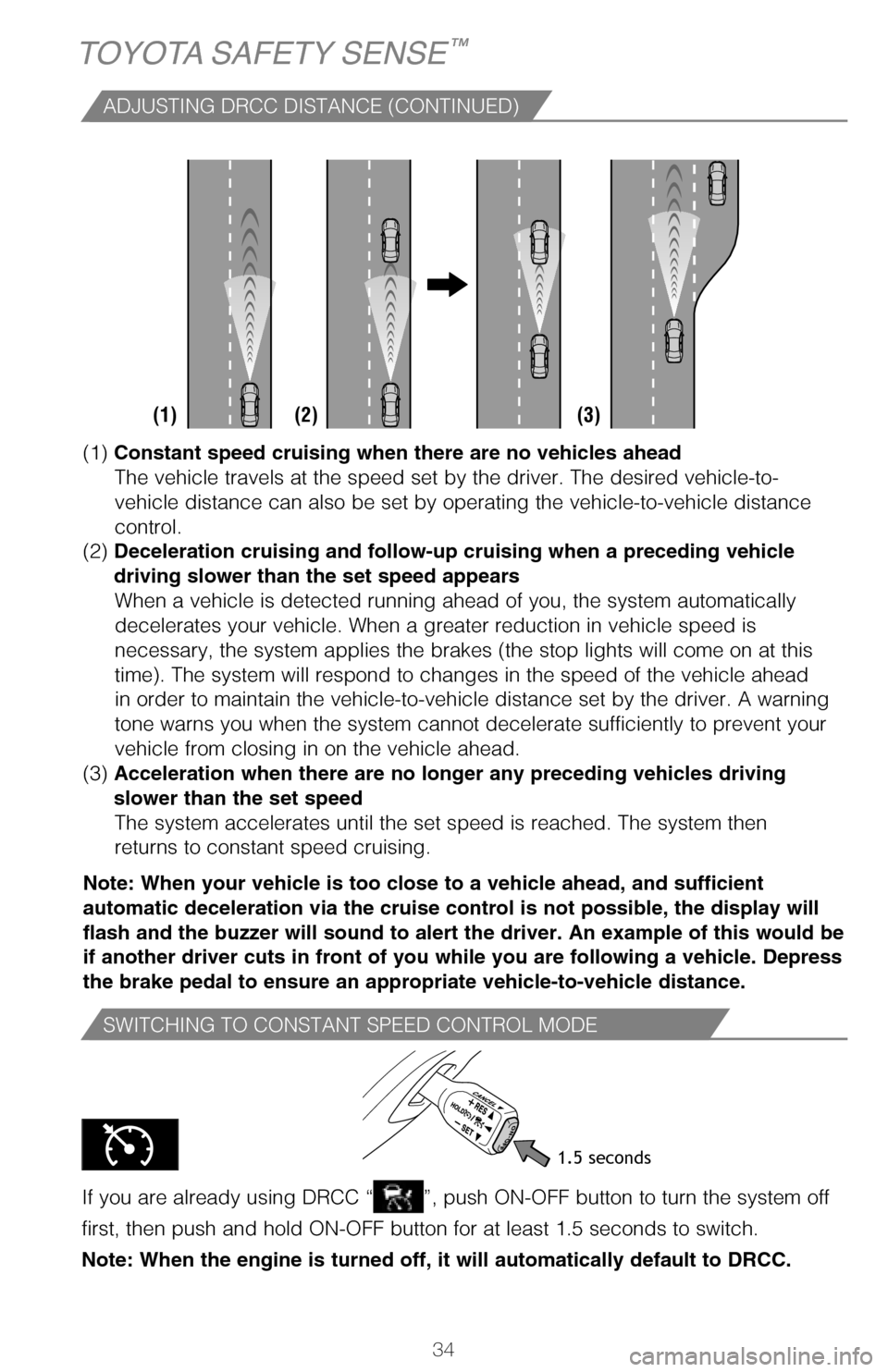
34
SWITCHING TO CONSTANT SPEED CONTROL MODE
If you are already using DRCC “”, push ON-OFF button to turn the system off
first, then push and hold ON-OFF button for at least 1.5 seconds to swit\
ch.
Note: When the engine is turned off, it will automatically default to DR\
CC.
TOYOTA SAFETY SENSE™
(1) With the engine switch in IGNITION ON mode and headlight switch tu\
rned to “AUTO” position, push lever away from you.
The “
” indicator will come on when the headlights are turned on
automatically to indicate that the system is active.
(2) Pull the lever back toward you to turn the AHB system off.
The “
” will turn off and the “” turns on.
When all of these conditions are met, high beams will be automatically t\
urned on
(after approximately 1 second): • Vehicle speed is above approximately 25 mph (40 km/h).
• The area ahead of the vehicle is dark.
• There are no oncoming or preceding vehicles with headlights or tail lights turned on.
• There are few street lights on the road ahead.
If any of these conditions occur, the system is designed to automaticall\
y turn off
high beams: • Vehicle speed drops below approximately 17 mph (27 km/h).
• The area ahead of the vehicle is not dark.
• Oncoming or preceding vehicles have headlights or tail lightsturned on.
• There are many streetlights on the road ahead.
ACTIVATING THE AHB SYSTEM
CONDITIONS WHERE AHB WILL TURN ON/OFF AUTOMATICALLY
1.5 seconds
(1) Constant speed cruising when there are no vehicles ahead
The vehicle travels at the speed set by the driver. The desired vehicle-\
to-
vehicle distance can also be set by operating the vehicle-to-vehicle dis\
tance
control.
(2) Deceleration cruising and follow-up cruising when a preceding vehicle
driving slower than the set speed appears When a vehicle is detected running ahead of you, the system automaticall\
y
decelerates your vehicle. When a greater reduction in vehicle speed is
necessary, the system applies the brakes (the stop lights will come on \
at this
time). The system will respond to changes in the speed of the vehicle a\
head
in order to maintain the vehicle-to-vehicle distance set by the driver. \
A warning
tone warns you when the system cannot decelerate sufficiently to prevent\
your
vehicle from closing in on the vehicle ahead.
(3) Acceleration when there are no longer any preceding vehicles driving
slower than the set speed The system accelerates until the set speed is reached. The system then
returns to constant speed cruising.
Note: When your vehicle is too close to a vehicle ahead, and sufficient \
automatic deceleration via the cruise control is not possible, the displ\
ay will
flash and the buzzer will sound to alert the driver. An example of this \
would be
if another driver cuts in front of you while you are following a vehicle\
. Depress
the brake pedal to ensure an appropriate vehicle-to-vehicle distance.
(1) (2) (3)
ADJUSTING DRCC DISTANCE (CONTINUED)
AHB is a safety system designed to help drivers see more of what’s ah\
ead at
nighttime without dazzling other drivers. When enabled, AHB uses an in-v\
ehicle
camera to help detect the headlights of oncoming vehicles and tail light\
s of
preceding vehicles, then automatically switches between high and low bea\
ms
as appropriate to provide the most light possible and enhance forward vi\
sibility.
By using high beams more frequently, the system may allow earlier detect\
ion of
pedestrians and obstacles.
Refer to a Toyota Owner’s Manual for additional information on AHB op\
eration,
settings adjustments, limitations, and precautions before attempting to \
use it.
2017_Highlander_QRG_V1_1.indd 3411/22/16 11:29 PM
Page 37 of 56
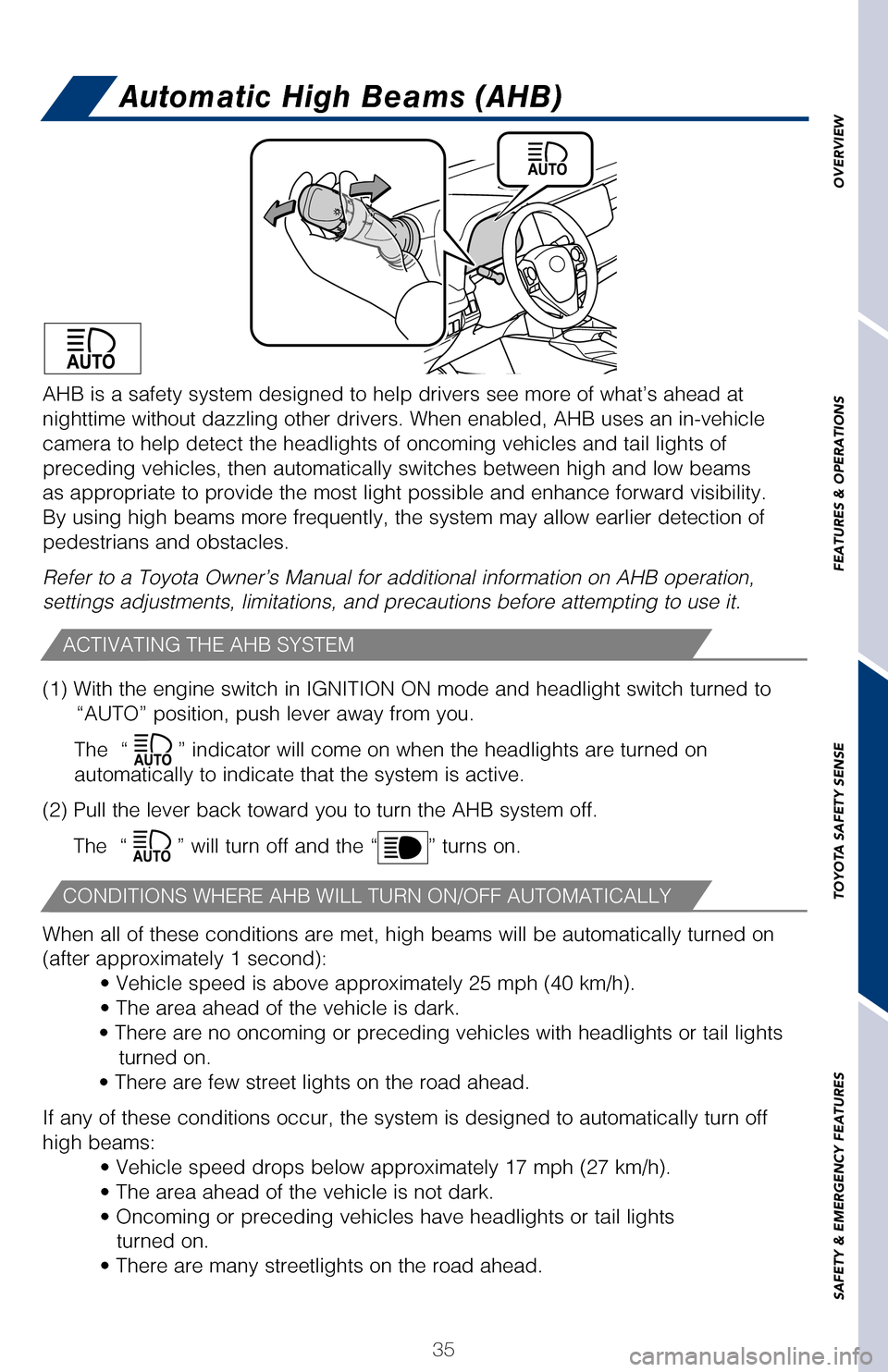
35
OVERVIEW
FEATURES & OPERATIONS
TOYOTA SAFETY SENSE
SAFETY & EMERGENCY FEATURES
If you are already using DRCC “”, push ON-OFF button to turn the system off
first, then push and hold ON-OFF button for at least 1.5 seconds to swit\
ch.
Note: When the engine is turned off, it will automatically default to DR\
CC.
Automatic High Beams (AHB)
(1) With the engine switch in IGNITION ON mode and headlight switch tu\
rned to “AUTO” position, push lever away from you.
The “
” indicator will come on when the headlights are turned on
automatically to indicate that the system is active.
(2) Pull the lever back toward you to turn the AHB system off.
The “
” will turn off and the “” turns on.
When all of these conditions are met, high beams will be automatically t\
urned on
(after approximately 1 second): • Vehicle speed is above approximately 25 mph (40 km/h).
• The area ahead of the vehicle is dark.
• There are no oncoming or preceding vehicles with headlights or tail lights turned on.
• There are few street lights on the road ahead.
If any of these conditions occur, the system is designed to automaticall\
y turn off
high beams: • Vehicle speed drops below approximately 17 mph (27 km/h).
• The area ahead of the vehicle is not dark.
• Oncoming or preceding vehicles have headlights or tail lightsturned on.
• There are many streetlights on the road ahead.
ACTIVATING THE AHB SYSTEM
CONDITIONS WHERE AHB WILL TURN ON/OFF AUTOMATICALLY
(1) Constant speed cruising when there are no vehicles ahead
The vehicle travels at the speed set by the driver. The desired vehicle-\
to-
vehicle distance can also be set by operating the vehicle-to-vehicle dis\
tance
control.
(2) Deceleration cruising and follow-up cruising when a preceding vehicle
driving slower than the set speed appears
When a vehicle is detected running ahead of you, the system automaticall\
y
decelerates your vehicle. When a greater reduction in vehicle speed is
necessary, the system applies the brakes (the stop lights will come on \
at this
time). The system will respond to changes in the speed of the vehicle a\
head
in order to maintain the vehicle-to-vehicle distance set by the driver. \
A warning
tone warns you when the system cannot decelerate sufficiently to prevent\
your
vehicle from closing in on the vehicle ahead.
(3) Acceleration when there are no longer any preceding vehicles driving
slower than the set speed The system accelerates until the set speed is reached. The system then
returns to constant speed cruising.
Note: When your vehicle is too close to a vehicle ahead, and sufficient \
automatic deceleration via the cruise control is not possible, the displ\
ay will
flash and the buzzer will sound to alert the driver. An example of this \
would be
if another driver cuts in front of you while you are following a vehicle\
. Depress
the brake pedal to ensure an appropriate vehicle-to-vehicle distance.
AHB is a safety system designed to help drivers see more of what’s ah\
ead at
nighttime without dazzling other drivers. When enabled, AHB uses an in-v\
ehicle
camera to help detect the headlights of oncoming vehicles and tail light\
s of
preceding vehicles, then automatically switches between high and low bea\
ms
as appropriate to provide the most light possible and enhance forward vi\
sibility.
By using high beams more frequently, the system may allow earlier detect\
ion of
pedestrians and obstacles.
Refer to a Toyota Owner’s Manual for additional information on AHB op\
eration,
settings adjustments, limitations, and precautions before attempting to \
use it.
2017_Highlander_QRG_V1_1.indd 3511/22/16 11:29 PM
Page 38 of 56
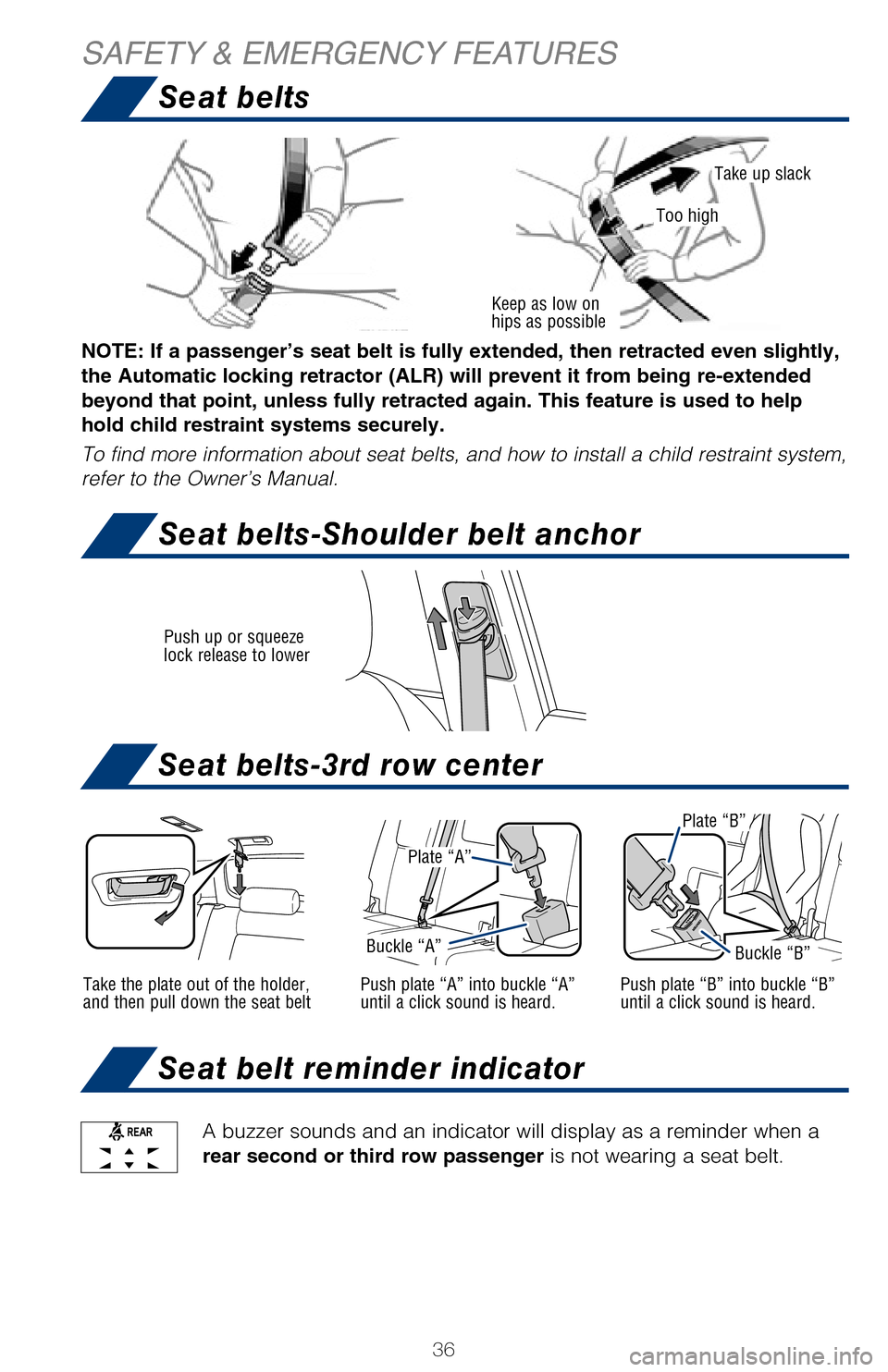
36
Push up or squeeze
lock release to lower
Seat belts
Seat belts-3rd row center
Seat belt reminder indicator
Seat belts-Shoulder belt anchor
SAFETY & EMERGENCY FEATURES
Moving the lever to the lock position will allow the door to be opened only fr\
om the
outside
A buzzer sounds and an indicator will display as a reminder when a
rear second or third row passenger is not wearing a seat belt.
Rear door
After adjusting tire pressures, or after tires have been rotated or replaced,\
turn the
ignition switch to “ON” and press and hold the
“ SET” button until indicator blinks
three times. Let the vehicle sit for a few minutes to allow initialization to\
complete.
Refer to the load label on the door jamb or the Owner’s Manual for tire in\
flation
specifications.
If the tire pressure indicator flashes for more than 60 seconds and then r\
emains on,
take the vehicle to your local Toyota dealer.
NOTE: The warning light may come on due to temperature changes or changes
in tire pressure from natural air leakage. If the system has not been init\
ialized
recently, setting the tire pressures to factory specifications should turn off th\
e
light.
Plate “A”
Buckle “A”
Plate “B”
Buckle “B”
Take the plate out of the holder,
and then pull down the seat beltPush plate “A” into buckle “A”
until a click sound is heard.
Plate “A”
Plate “B”
Buckle “A”Buckle “B”
Push plate “B” into buckle “B”
until a click sound is heard.
Keep as low on
hips as possible
Take up slack
Too high
NOTE: If a passenger’s seat belt is fully extended, then retracted even sl\
ightly,
the Automatic locking retractor (ALR) will prevent it from being re-exten\
ded
beyond that point, unless fully retracted again. This feature is used to help
hold child restraint systems securely.
To find more information about seat belts, and how to install a child rest\
raint system,
refer to the Owner’s Manual.
2017_Highlander_QRG_V1_1.indd 3611/22/16 11:29 PM
Page 39 of 56
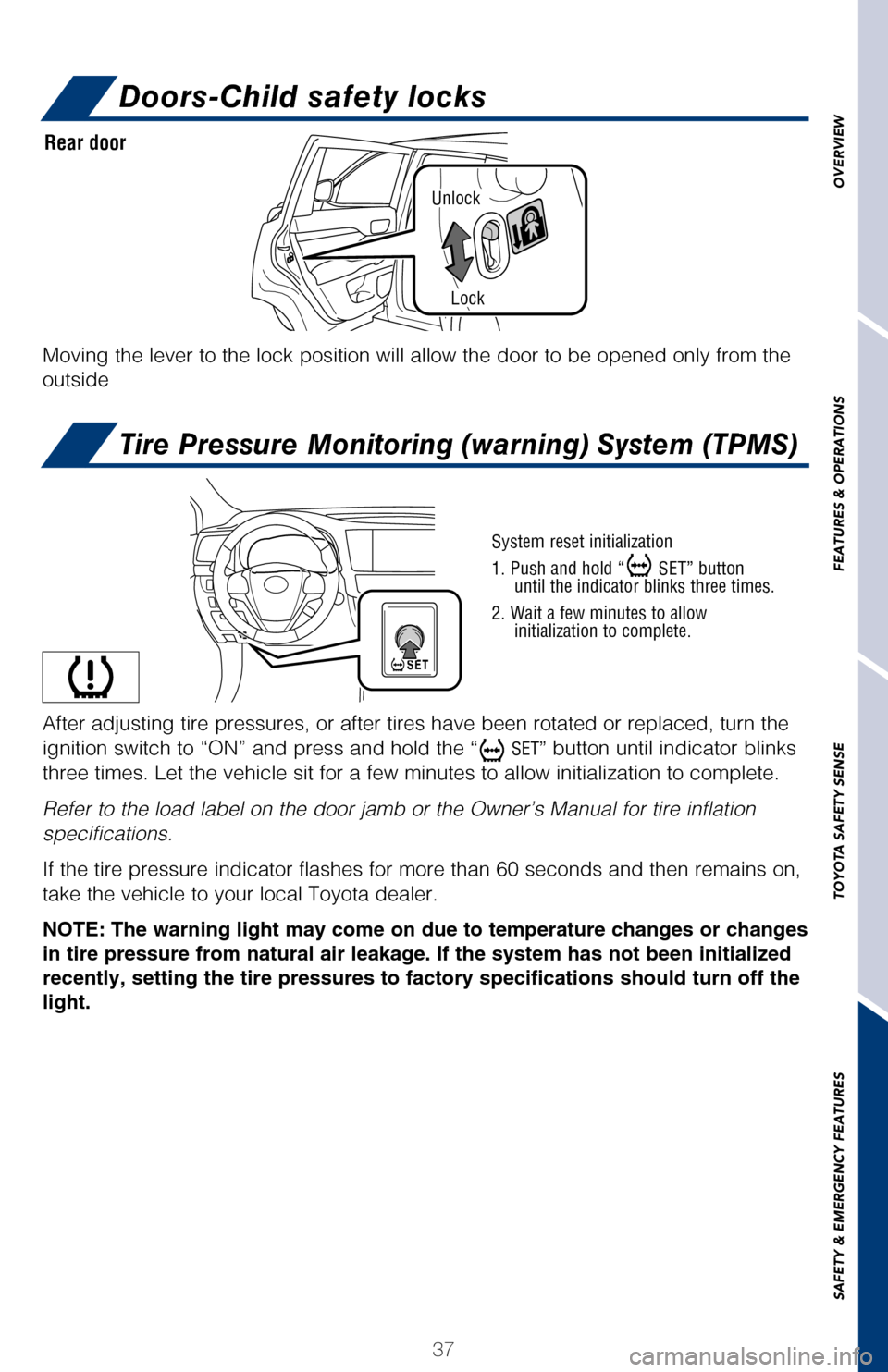
37
Unlock
Lock
OVERVIEW
FEATURES & OPERATIONS
TOYOTA SAFETY SENSE
SAFETY & EMERGENCY FEATURES
Seat beltsDoors-Child safety locks
Seat belts-3rd row center
Seat belt reminder indicator
Seat belts-Shoulder belt anchor
Tire Pressure Monitoring (warning) System (TPMS)
Moving the lever to the lock position will allow the door to be opened o\
nly from the
outside
A buzzer sounds and an indicator will display as a reminder when a
rear second or third row passenger is not wearing a seat belt.
Rear door
System reset initialization
1. Push and hold “
SET” button
until the indicator blinks three times.
2. Wait a few minutes to allow initialization to complete.
After adjusting tire pressures, or after tires have been rotated or repl\
aced, turn the
ignition switch to “ON” and press and hold the
“ SET” button until indicator blinks
three times. Let the vehicle sit for a few minutes to allow initializati\
on to complete.
Refer to the load label on the door jamb or the Owner’s Manual for ti\
re inflation
specifications.
If the tire pressure indicator flashes for more than 60 seconds and then\
remains on,
take the vehicle to your local Toyota dealer.
NOTE: The warning light may come on due to temperature changes or changes
in tire pressure from natural air leakage. If the system has not been in\
itialized
recently, setting the tire pressures to factory specifications should tu\
rn off the
light.
Buckle “B”
Push plate “B” into buckle “B”
until a click sound is heard.
Take up slack
NOTE: If a passenger’s seat belt is fully extended, then retracted ev\
en slightly,
the Automatic locking retractor (ALR) will prevent it from being re-ex\
tended
beyond that point, unless fully retracted again. This feature is used to\
help
hold child restraint systems securely.
To find more information about seat belts, and how to install a child re\
straint system,
refer to the Owner’s Manual.
2017_Highlander_QRG_V1_1.indd 3711/22/16 11:29 PM
Page 44 of 56
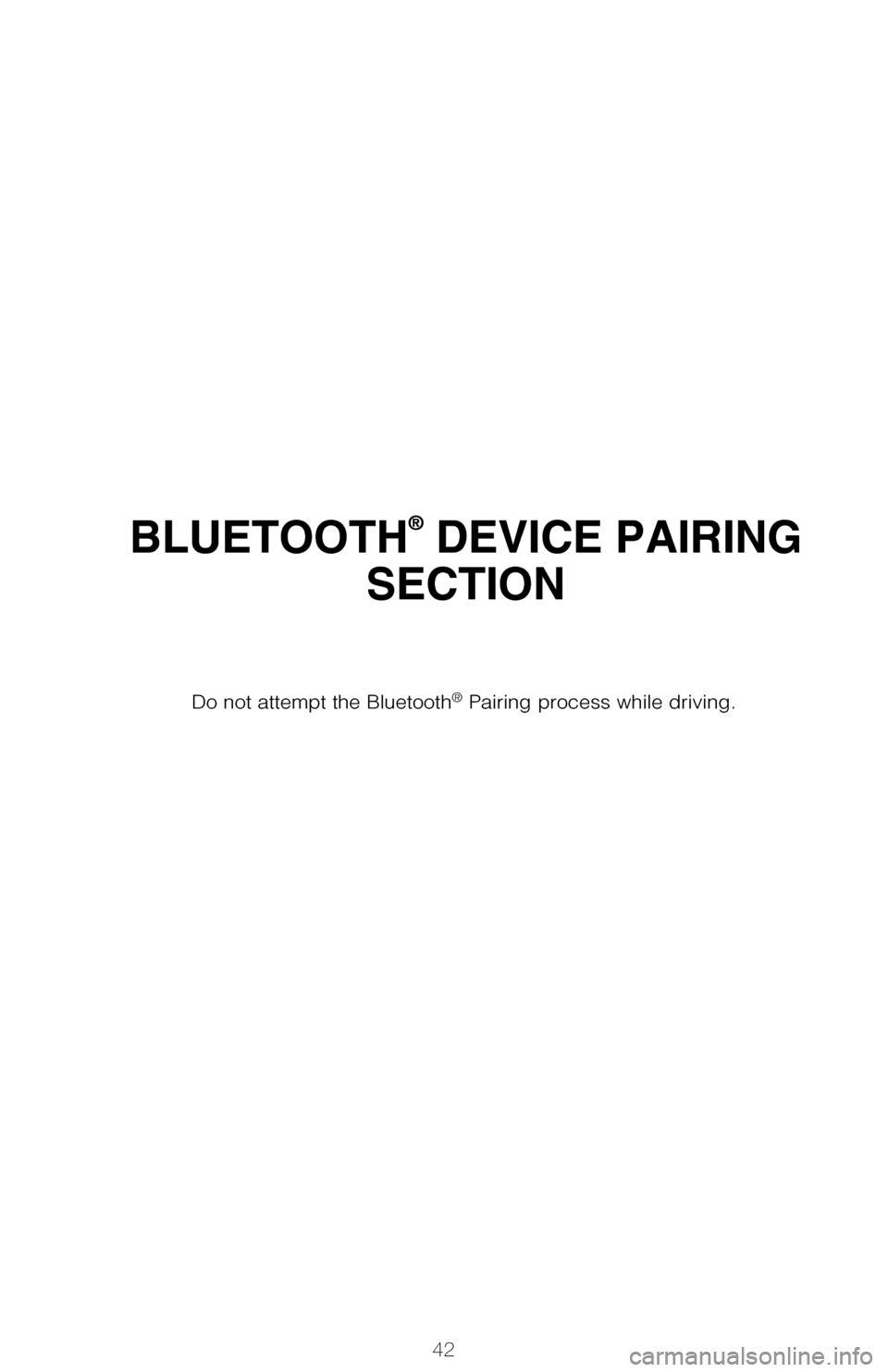
42
BLUETOOTH® DEVICE PAIRING
SECTION
Pairing your phone is the first step in connecting with your Toyota for hands-f\
ree
calling and for audio streaming via Bluetooth. This pairing process is quick an\
d
easy: all Android mobile digital devices have Bluetooth integrated; all you h\
ave to
do is setup the phone and multimedia system to “talk” to each other \
and form a
connection.2
Initiate Bluetooth® on your Android®
STEP 1
From your APPS
SCREEN, select
SETTINGS.
1 To determine which head unit is installed in your vehicle, refer to the Au\
dio section in this guide.
Entune™ Premium Audio screens are shown in this section. Screens and features \
may vary by
Entune™ system. 2 Some Android devices may have slightly different SETTINGS screen layout\
depending on manu- facturer of device and Android OS version.
To begin the Bluetooth® Pairing process, press the HOME button on the faceplate of
your Toyota Vehicle Entune™ Multimedia Head Unit.1
Do not attempt the Bluetooth® Pairing process while driving.
2017_Highlander_QRG_V1_1.indd 4211/22/16 11:29 PM